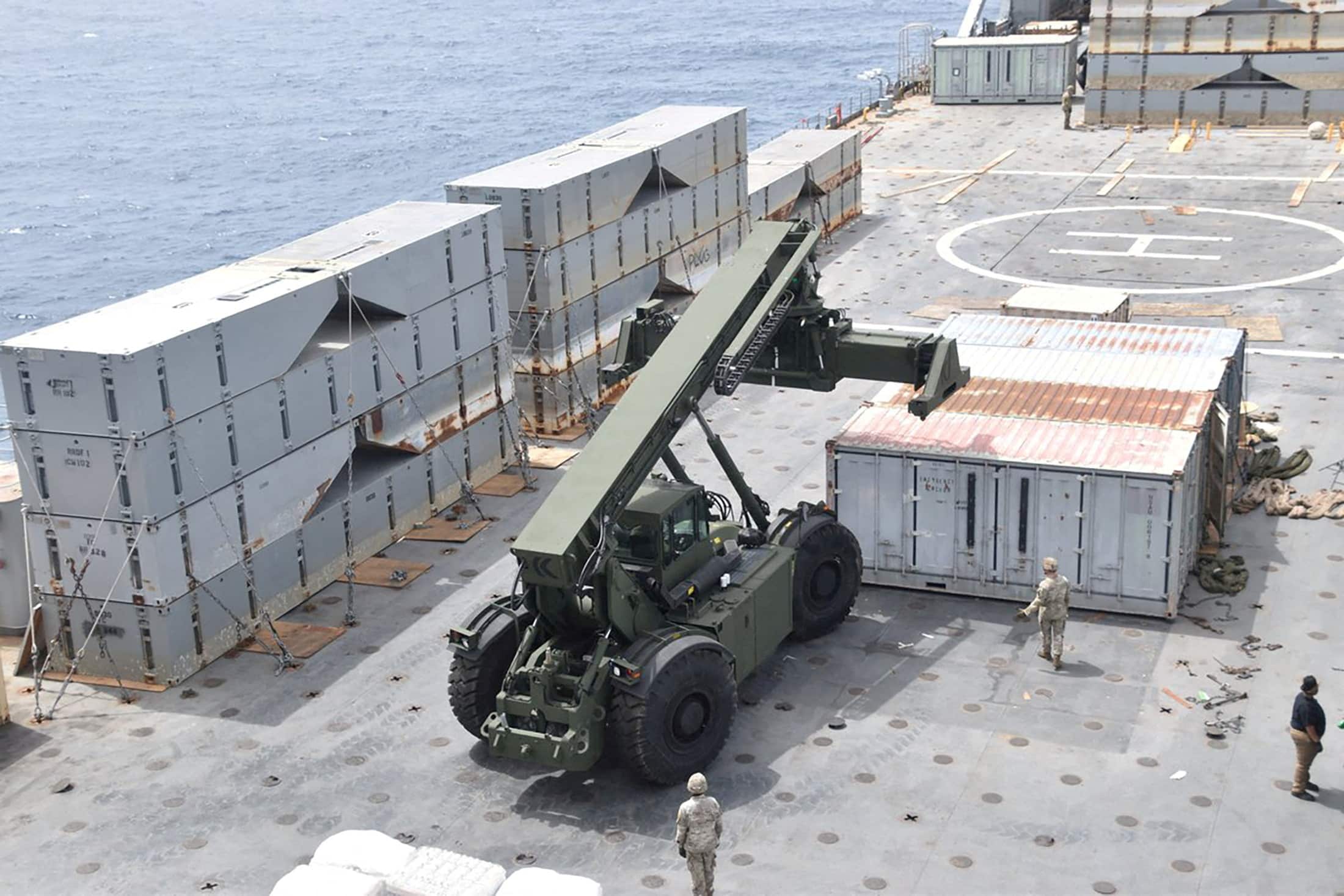Aid sent from Cyprus to Gaza by the United States is to begin arriving ashore “in the coming days”, US Agency for International Development (USAid) spokeswoman Sonali Korde said on Friday.
Meanwhile, European Commission spokesperson for humanitarian aid and crisis management Balas Ujvari said later in the day that a shipment of aid sent from Romania had left Larnaca and was en route to Gaza and was expected to arrive at the temporary jetty off the coast of Gaza on the same day.
On Friday morning, satellite-based maritime trackers showed the ship the USAV Major General Charles P Gross to be stationary off the coast of Gaza. The ship is a roll-on/roll-off US Army ship.
While far from definitive, the ship’s placement may give some indication as to where the temporary jetty constructed to facilitate the delivery of aid may have been anchored.
The US Central Command announced on Thursday morning that the jetty had been put into place off Gaza’s coast, but questions had still remained regarding its placement.
British newspaper The Guardian had reported last week that the jetty’s placement may have been too far south to help alleviate the “very high” risk of famine in the northern part of Gaza.
The north of Gaza, including Gaza City, has been effectively cut off from the rest of the strip by a military road constructed by the Israeli Defence Force which connects Israel with Gaza’s coast, known as the Netzarim corridor.
However, the USAV Major General Charles P Gross is according to satellite data located north of the Netzarim corridor, indicating that the jetty may also be located to the north, thus more easily facilitating the aid to those who most need it.
Ujvari told journalists on Friday afternoon that the Romanian aid shipment, coordinated by the European Union’s Civil Protection Mechanism, consists of 88,000 cans of food, and that the European Commission is covering the transport costs for the aid.
European Commission chief spokesman Eric Mamer explained that “the jetty was completed yesterday, so, as you can see, we are wasting no time making use of it.”
At the same time, the EU has established a coordination hub in Cyprus to manage the flow of humanitarian aid to Gaza, with the EU’s Emergency Response Coordinaton Centre coordinating member states and partner countries to promote the provision of more aid via the corridor.
European Commissioner for crisis management Janez Lenarcic said he welcomed the shipment, but said, “it is obvious there is no substantial substitute for land routes through Egypt and Jordan and entry points from Israel to Gaza for large-scale aid delivery.”
“The maritime corridor can only be part of an ongoing effort to increase humanitarian aid and commercial goods to Gaza through all possible channels,” he added, calling on Israel to open up more crossing points into Gaza.
Speaking to journalists on Friday, Korde said more American aid is currently arriving in Cyprus, “where it will be screened for loading onto ships for delivery to Gaza by sea.
“Currently, we are providing nutrient-rich food bars for 11,000 of the most vulnerable, ready-to-use therapeutic foods to treat 7,200 children with the most life-threatening forms of malnutrition, and enough relief supplies like hygiene kits for 30,000 people through the humanitarian corridor,” she said.
She added that once the supplies arrive in Gaza, humanitarian organisations will “determine how to ensure they reach those in greatest need”.
She also touched on the ongoing humanitarian crisis in Gaza, saying, “across Gaza, 2.2 million people – the entire population – is facing acute food insecurity.
“More than half of the population in the north is at catastrophic levels, and I want to underscore just how dire this is for the most vulnerable, particularly mothers and children,” she added.
She said that for this reason, her country is “working tirelessly to surge assistance through all available means to address the impacts of this crisis.
“To mitigate and counter the threat of famine and extreme food security, humanitarian organisations are working to increase lifesaving food assistance, but food alone is not enough.”
She went on to say, “while aid has increasingly entered Gaza in recent weeks, more needs to be done now, especially in light of recent setbacks.”
US Central Command deputy commander Vice Admiral Brad Cooper also spoke, focusing on the logistics of the operation.
He said there are 1,000 US soldiers and sailors “committed to this mission”, and that 14 ships belonging to the US and “partner nations” are “solely focused on this one mission to deliver assistance to the people of Gaza.”
He added that three additional US ships are set to join the mission in the coming week, while the United Kingdom is also expected to offer the services of the RFA Cardigan Bay for “logistics support”.
At present, he said, “we have hundreds of tonnes of aid on ships in the Eastern Mediterranean ready for delivery. Thousands of tonnes of aid are in the pipeline. We are seeing significant volumes of aid flow into Cyprus for further distribution, and we expect this flow will continue as more international donors contribute.”
He added that Cyprus has been “highly supportive of this overall effort to establish a maritime corridor”, and that the US now has two “coordination cells” in place in the region; one in Cyprus and one in Israel.
The US Central command had announced on Thursday morning that the temporary jetty which will facilitate the delivery of humanitarian aid to Gaza had been put into place off Gaza’s coast.
Meanwhile, the latest shipment of humanitarian aid from Cyprus had set sail late on Wednesday night.
The aid aboard the ship was supplied by the British government and consists of 8,400 shelter coverage kits, which are temporary shelters made up of plastic sheeting. The total weight of the shipment is almost 100 tonnes.
Now it is in place, the jetty’s capacity will begin at 90 lorryloads per day, rising to 150 per day once the operation is in full swing. Vice Admiral Cooper said on Friday this translates to around 500 tons (454 tonnes) per day.
Questions were raised regarding the capacity, which some perceived as low. In response, Pentagon spokeswoman Sabrina Singh last week highlighted that the jetty is a “temporary” solution, and that “the best way” to transfer humanitarian aid into Gaza was through land routes.
In addition, questions had been raised over the cost of the jetty’s construction, with news website Reuters having reported that it had cost a total of $320 million (€298m) to build.
That cost is around double that of original estimates, according to US Senator Roger Wicker.
Wicker, a Republican from the state of Mississippi, said “this dangerous effort with marginal benefits will now cost the American taxpayer at least $320m to operate the pier for only 90 days.”







Click here to change your cookie preferences